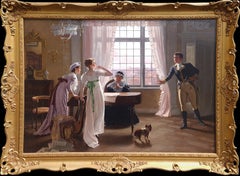Max Volkhart
19th Century Romantic Figurative Paintings
Canvas, Oil
People Also Browsed
Antique 19th Century German Black Forest Side Chairs
Walnut
Vintage 1960s French Prints
Paper
Antique Mid-19th Century French Louis Philippe Mantel Mirrors and Firepl...
Gold Leaf
Antique 1820s English George III Settees
Brass
Early 20th Century German Black Forest Animal Sculptures
Wood
Antique Late 18th Century English George III Drop-leaf and Pembroke Tables
Mahogany
Early 20th Century Burmese Textiles
Early 20th Century French Belle Époque Table Clocks and Desk Clocks
Jade, Silver
Antique 19th Century French Napoleon III Vases
Bronze, Ormolu
Antique 19th Century English Regency Armchairs
Leather, Mahogany
Antique 19th Century French Louis XVI Mantel Clocks
Bronze
Antique 19th Century French Restauration Fireplaces and Mantels
Bronze
Antique Mid-19th Century British Louis XVI Center Tables
Ormolu
Antique Late 19th Century American Musical Instruments
Mahogany
Antique Early 19th Century French Mantel Clocks
Bronze
Antique 18th Century and Earlier British Wine Coolers
A Close Look at Romantic Art
In emphasizing emotion and imagination, romantic art shifted away from the restraint of classicism and neoclassicism that had dominated art in Europe since the Renaissance. Romanticism achieved its greatest popularity in art, literature, music and philosophy between 1780 and 1830, although its expression of individual experiences ranging from awe to passion informed culture in the decades after.
Landscape painting was especially popular during the romantic period, as were nature studies of wild animals and fantasies of exotic lands. Romanticism varied across Europe as it reacted to the rise of industrialization, a more personal relationship with faith that was distanced from the church and the rationalist thinking of the Enlightenment.
British painters such as John Constable and J.M.W. Turner responded dramatically to the light and atmosphere of the natural world, while William Blake conveyed humanity’s connection to the divine in his visionary art. In Germany, the late-18th-century Sturm und Drang, or Storm and Drive, movement, with its probing of the unconscious, inspired a sense of mystery in work by romantic artists such as Caspar David Friedrich and Philipp Otto Runge. In France, where the French Revolution had turned tradition upside down, Théodore Géricault and Eugène Delacroix used lush brushwork to paint monumental canvases with tumultuous scenes of nature and history.
The romantic movement and its subject matter were a significant influence on the Pre-Raphaelites, Symbolists and the American painters of the Hudson River School, as well as on other cultural movements in the 19th and 20th centuries that saw artists build on this perspective in which art was guided by emotion rather than reason.
Find a collection of romantic paintings, sculptures, prints and multiples and more art on 1stDibs.
Finding the Right Figurative-paintings for You
Figurative art, as opposed to abstract art, retains features from the observable world in its representational depictions of subject matter. Most commonly, figurative paintings reference and explore the human body, but they can also include landscapes, architecture, plants and animals — all portrayed with realism.
While the oldest figurative art dates back tens of thousands of years to cave wall paintings, figurative works made from observation became especially prominent in the early Renaissance. Artists like Michelangelo, Leonardo da Vinci and other Renaissance masters created naturalistic representations of their subjects.
Pablo Picasso is lauded for laying the foundation for modern figurative art in the 1920s. Although abstracted, this work held a strong connection to representing people and other subjects. Other famous figurative artists include Francis Bacon and Lucian Freud. Figurative art in the 20th century would span such diverse genres as Expressionism, Pop art and Surrealism.
Today, a number of figural artists — such as Sedrick Huckaby, Daisy Patton and Eileen Cooper — are making art that uses the human body as its subject.
Because figurative art represents subjects from the real world, natural colors are common in these paintings. A piece of figurative art can be an exciting starting point for setting a tone and creating a color palette in a room.
Browse an extensive collection of figurative paintings on 1stDibs.
